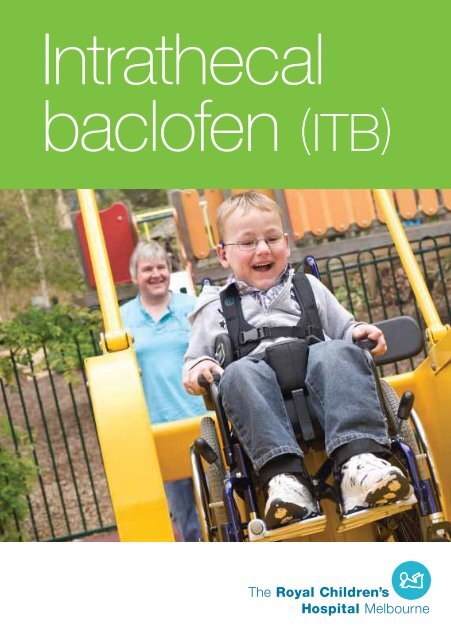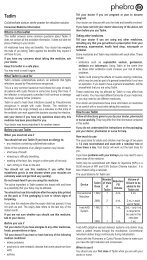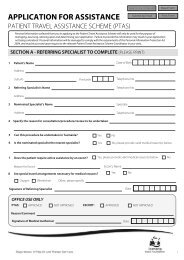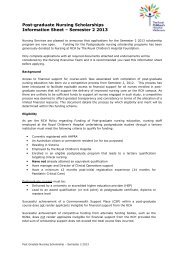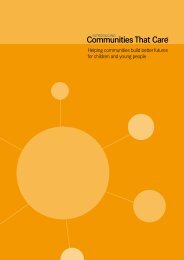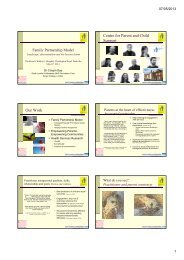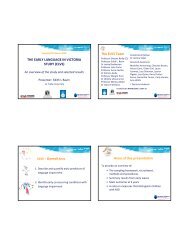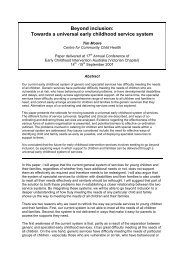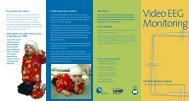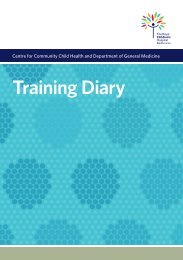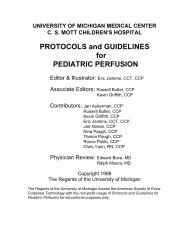Intrathecal Baclofen Booklet - The Royal Children's Hospital
Intrathecal Baclofen Booklet - The Royal Children's Hospital
Intrathecal Baclofen Booklet - The Royal Children's Hospital
Create successful ePaper yourself
Turn your PDF publications into a flip-book with our unique Google optimized e-Paper software.
<strong>Intrathecal</strong><br />
baclofen (ITB)
Contents<br />
Page<br />
Section<br />
1 Introduction<br />
2 Who might be suitable for ITB<br />
3 Complex Movement Disorder program<br />
4 CMD clinic assessments<br />
5 ITB therapy trials<br />
8 Operation for insertion of an ITB pump<br />
11 When your child has an ITB pump<br />
17 Frequently asked questions<br />
Your ITB team<br />
Your ITB nurse is:<br />
Telephone:<br />
Your ITB doctor is:<br />
Your managing ITB team is:<br />
Business hours please contact:<br />
After hours please contact:<br />
Notes:<br />
This book was written by members of the Complex Movement Disorders team,<br />
<strong>The</strong> <strong>Royal</strong> Children’s <strong>Hospital</strong>, Melbourne. We gratefully acknowledge the generous financial<br />
support of the Waverley Auxiliary who provided the funding for printing this booklet.
Introduction<br />
What is intrathecal baclofen<br />
<strong>Intrathecal</strong> baclofen (ITB) is a well established therapy<br />
for children with movement problems. <strong>Baclofen</strong> is a<br />
medicine that helps the muscles relax. It can be given<br />
by mouth or ‘intrathecally’ which means delivered into<br />
the space around the spinal cord. Oral baclofen is<br />
usually tried first but if it doesn’t work well, intrathecal<br />
baclofen might be considered.<br />
ITB is injected into the fluid around the<br />
spinal cord through a very fine tube<br />
(called a catheter). This tube is connected<br />
to a surgically implanted permanent pump<br />
that is placed in the abdomen.<br />
This booklet contains general information<br />
to help parents and families understand<br />
the ITB treatment process, and describes<br />
services available. Further information is<br />
available on <strong>The</strong> <strong>Royal</strong> Children’s <strong>Hospital</strong><br />
website at www.rch.org.au/kidsinfo<br />
and useful contact details are printed on<br />
the back cover of this booklet.<br />
How you say it:<br />
<strong>Intrathecal</strong> In-tra-thee-cal<br />
<strong>Baclofen</strong> Back-low-fen<br />
<strong>Intrathecal</strong> baclofen |<br />
1
Who might be suitable for ITB<br />
Children and adolescents with moderate<br />
to severe spasticity or dystonia that affects<br />
care, comfort, quality of life, and function<br />
may benefit from ITB. Many of these<br />
children and adolescents have cerebral<br />
palsy; many others have an acquired brain<br />
injury (ABI) following trauma or stroke, or<br />
other more rare neurological conditions.<br />
However there are many factors to consider<br />
when deciding if your child should have ITB<br />
treatment. ITB does not suit every child or<br />
every family. Being part of the ITB program<br />
puts limitations on certain parts of your<br />
child’s life. You have to live close to a<br />
medical centre that can manage the ITB<br />
and you have to be able to attend many<br />
appointments. All the people that care for<br />
your child need to be willing to learn about<br />
ITB and its side effects; your child’s age<br />
and weight also need to be taken<br />
into consideration.<br />
2<br />
<strong>Intrathecal</strong> baclofen<br />
|<br />
What is spasticity<br />
Spasticity is a motor disorder where the<br />
muscles contract involuntarily making the<br />
muscles tighter than they should be. It is<br />
usually caused by damage to the portion<br />
of the brain or spinal cord that controls<br />
voluntary movement. <strong>The</strong> degree of<br />
spasticity (or ‘stiffness’) can vary from<br />
person to person. It may occur in<br />
children with cerebral palsy, ABI, and<br />
other more unusual conditions of the<br />
brain or spinal cord.<br />
What is dystonia<br />
Dystonia is a movement disorder where<br />
there are sustained muscle contractions<br />
that frequently cause twisting or repetitive<br />
movements or abnormal postures. <strong>The</strong>se<br />
movements can be painful and cannot be<br />
controlled by the person. Dystonia can<br />
affect just a single body part or be<br />
generalised to most or all of the body.<br />
Dystonia can also result from the same<br />
causes as spasticity, that is, cerebral palsy,<br />
ABI and other more unusual conditions<br />
of the brain and spinal cord. It may also<br />
occur as a result of an adverse drug<br />
reaction or a brain tumour.
Complex Movement Disorder program<br />
Referral, consultation<br />
and assessment<br />
A referral to the Complex Movement<br />
Disorder (CMD) program can be made<br />
by members of the CMD team, or other<br />
doctors or therapists from within the<br />
hospital. Once a referral has been made<br />
for assessment for ITB, your child’s case<br />
history will be presented at a CMD<br />
team meeting.<br />
At this meeting your child’s suitability<br />
for ITB will be considered. <strong>The</strong> CMD team<br />
will review your child’s medical history, past<br />
treatments, video footage of your child’s<br />
movement problem (if available), and make<br />
an assessment of whether ITB may be<br />
appropriate. At this team meeting, other<br />
forms of therapy are also considered.<br />
<strong>The</strong> first stage of assessment usually<br />
involves a consultation with either the<br />
paediatrician or rehabilitation physician.<br />
This is to ensure that other forms of<br />
treatment, such as oral medications for<br />
spasticity or dystonia have been tried,<br />
and also to ensure that other medical<br />
problems, which may make spasticity<br />
or dystonia worse have been treated.<br />
If thought that your child may be suitable<br />
for ITB, your child will then be assessed<br />
in the CMD clinic.<br />
<strong>The</strong> CMD program at <strong>The</strong> <strong>Royal</strong><br />
Children’s <strong>Hospital</strong> (RCH) comprises<br />
a multidisciplinary team made up of<br />
doctors, therapists and nurses.<br />
Complex movement disorder team meeting<br />
Who is in the CMD team<br />
• Cerebral palsy clinical nurse<br />
coordinator<br />
• Clinical nurse consultant –<br />
intrathecal baclofen and<br />
complex movement disorders<br />
• Consultant paediatrician/rehabilitation<br />
physician<br />
• Gait laboratory physiotherapist<br />
• Neurologist<br />
• Neurosurgeon<br />
• Occupational therapist<br />
• Orthopaedic surgeon<br />
• Physiotherapist<br />
• Speech pathologist<br />
• Rehabilitation nurse coordinator<br />
<strong>Intrathecal</strong> baclofen<br />
| 3
CMD assessments<br />
<strong>The</strong> CMD clinic is a multidisciplinary clinic.<br />
Your child will be assessed by a number<br />
of different health professionals working<br />
together. <strong>The</strong> assessment takes about<br />
one and a half hours. <strong>The</strong> assessment<br />
team includes:<br />
• Consultant paediatrician /rehabilitation<br />
physician<br />
ITB assessment team<br />
• Neurosurgeon<br />
• Physiotherapist<br />
• Occupational therapist<br />
• Speech pathologist<br />
4<br />
• Clinical nurse consultant – intrathecal<br />
baclofen / complex movement disorders<br />
What to expect<br />
At the CMD clinic, you and your child will<br />
be asked a series of questions. <strong>The</strong>se will<br />
focus on your child’s day-to-day life, and<br />
their abilities and challenges. An important<br />
part of the assessment is to understand<br />
what you and your child hope to achieve<br />
with ITB, and on the basis of this, to set<br />
some clear and specific goals.<br />
Your child’s community or school-based<br />
therapist may also be contacted prior<br />
to the clinic assessment. <strong>The</strong>y are invited<br />
to attend the assessment. In their<br />
absence we ask them to complete<br />
a written assessment of your child’s<br />
movement disorder, current issues<br />
and priorities.<br />
<strong>Intrathecal</strong> baclofen<br />
|<br />
Physical assessments<br />
Your child will also have a series of<br />
physical assessments. <strong>The</strong>se assessments<br />
range from a physical examination,<br />
to your child carrying out specific tasks.<br />
<strong>The</strong> assessments will vary depending on<br />
your child, and goals of treatment. <strong>The</strong>se<br />
assessments are video-taped. <strong>The</strong>se<br />
videos are only used for the assessment and<br />
follow-up of your child in the CMD program.<br />
<strong>The</strong> videos can only be used<br />
with the specific permission of you and<br />
your child. Your child’s equipment needs and<br />
therapy requirements will also be discussed.<br />
At the end of your appointment<br />
Following the assessments, you will be<br />
given more detailed information about ITB.<br />
You will also be given written material to<br />
take away with you to read.<br />
You and your child will have a chance to<br />
ask questions. It might be helpful to write<br />
down any questions you may have, before<br />
the visit.<br />
After your child’s CMD assessment<br />
You will be given an opportunity to think<br />
about everything that has happened at the<br />
CMD clinic, and about the information you<br />
have been given. You are encouraged to<br />
talk with your family and other support<br />
people about ITB. All the results of the<br />
assessment are then discussed with the<br />
CMD program members.<br />
Together the team decide whether your<br />
child should go to the next step of the<br />
process which involves a trial of ITB.<br />
You will be contacted after this discussion<br />
to see if you have any other questions, and<br />
if the team recommend that your child may<br />
be suitable for a trial with ITB you will be<br />
asked whether you would like to proceed<br />
with the trial.
ITB therapy trials<br />
<strong>The</strong> next stage of the assessment is a trial of ITB. <strong>The</strong> aim of this stage is assess<br />
whether the ITB works for your child before implanting an ITB pump.<br />
<strong>The</strong>re are two types of trial:<br />
1. Bolus trial<br />
2. Catheter trial<br />
<strong>The</strong> type of trial will be determined at the assessment.<br />
1. Bolus trial<br />
A bolus trial involves the injection<br />
of a single dose of ITB into the space<br />
surrounding your child’s spinal cord.<br />
<strong>The</strong> bolus is given via a lumbar puncture.<br />
A lumbar puncture involves introducing a<br />
small needle into the space surrounding<br />
the spinal cord. <strong>The</strong> ITB is then injected<br />
through the needle. <strong>The</strong> lumbar puncture<br />
will be performed either under sedation<br />
from nitrous oxide (laughing gas) or under<br />
general anaesthetic. This procedure takes<br />
30 minutes or more.<br />
Your child will be admitted to a ward<br />
and must remain in bed for at least two<br />
hours after the lumbar puncture. A doctor,<br />
physiotherapist and occupational therapist<br />
will observe your child approximately<br />
every two hours and assess how baclofen<br />
has affected your child’s muscles.<br />
<strong>The</strong> therapists will examine the stiffness<br />
and range of motion in your child’s muscles.<br />
<strong>The</strong> ITB usually starts to work about one<br />
hour after the injection. <strong>The</strong> effects of<br />
baclofen start to wear off after four hours.<br />
<strong>The</strong> lumbar puncture may cause your<br />
child to develop a headache, and he/she<br />
may also experience side effects from<br />
the anaesthetics such as vomiting.<br />
If this occurs, your child may have to stay<br />
overnight for further observation. However<br />
if your child is well, he/she will be<br />
discharged in the late afternoon.<br />
If the trial is successful and you and<br />
your child wish to proceed and have<br />
a pump implanted, an appointment will<br />
be made for you to see a neurosurgeon<br />
to discuss the option of a pump and the<br />
procedure involved.<br />
Lumbar puncture procedure<br />
<strong>Intrathecal</strong> baclofen<br />
| 5
position of the trial catheter and access port<br />
Catheter inserted into<br />
spinal column<br />
Trial catheter and<br />
access port<br />
<strong>Intrathecal</strong> baclofen<br />
|<br />
6 Spinal column
2. Catheter (tube) trial<br />
<strong>The</strong> catheter trial is more extensive than<br />
the bolus trial. It allows assessment of what<br />
effect higher doses of ITB will have on your<br />
child’s movements. For this type of trial your<br />
child is required to be admitted for two<br />
inpatient stays.<br />
Staying in hospital for the<br />
catheter trial<br />
Stay 1. Insertion of the catheter and<br />
access port<br />
<strong>The</strong> catheter and access port are put in<br />
by the neurosurgeon whilst your child is in<br />
the operating room and is under a general<br />
anaesthetic. <strong>The</strong> insertion of the port and<br />
catheter is usually a separate admission to<br />
the trial. <strong>The</strong> catheter is inserted into the<br />
spine and is then connected to an access<br />
port, which sits just under the skin on the<br />
abdomen.<br />
Your child will then be discharged home<br />
to recover from this surgery. He/she will<br />
be readmitted at a later date for trial<br />
of the ITB. Your child may have some<br />
pain resulting from the surgery. Regular<br />
analgesia (pain relief medication) will be<br />
given and staff will ensure that your child<br />
remains comfortable.<br />
Stay 2. Trial of ITB<br />
Your child is readmitted for an inpatient<br />
stay of approximately 3 – 5 days This is<br />
usually within four months of the port<br />
being implanted. A needle is inserted<br />
through the skin into the access port.<br />
A local anaesthetic cream called ‘Angel’<br />
or ‘Emla’ cream is placed on the skin over<br />
the access port site on the abdomen.<br />
This cream will numb the skin so there<br />
should be no pain from the needle.<br />
<strong>The</strong> needle is attached to tubing and<br />
a small external pump. <strong>The</strong> baclofen will<br />
be delivered to the spine by the pump.<br />
Only your baclofen doctor and the clinical<br />
nurse consultant will alter the dose<br />
of baclofen.<br />
During the trial your child will be able to<br />
get out of bed and move around – that is<br />
walking if they are able, or moving around<br />
in their wheelchair. Throughout the trial<br />
your child will be assessed for the effect<br />
baclofen has had on your child’s muscles.<br />
<strong>The</strong> therapists will examine the stiffness and<br />
range of motion in your child’s muscles.<br />
In addition, your child will be assessed<br />
and videotaped performing specific activity<br />
goals that he/she would like to achieve with<br />
ITB treatment. During the trial the amount<br />
of baclofen may be altered to assess the<br />
impact of the altered dose on your child’s<br />
movements while monitoring for any<br />
side effects.<br />
When all the assessments are complete<br />
and the ITB team are satisfied with<br />
assessments, the medication is stopped<br />
and the needle is removed. Your child<br />
will be discharged home.<br />
If an improvement is observed in your<br />
child’s muscle tone and you wish to<br />
proceed, a date will be made for the access<br />
port to be removed and the baclofen pump<br />
will then be attached to the catheter that is<br />
in place. This may be done during the same<br />
admission or you may need to return to<br />
the hospital at a later date.<br />
Useful information about RCH<br />
For more information about RCH and its<br />
facilities, please read ‘Your Guide to <strong>The</strong><br />
<strong>Royal</strong> Children’s <strong>Hospital</strong>’. This is a free<br />
booklet and is given to families at the time<br />
of admission. It is also available in all clinic<br />
areas and the Family Resource Centre at<br />
RCH. It is also available online at:<br />
www.rch.org.au/rchinfo<br />
<strong>Intrathecal</strong> baclofen<br />
| 7
Operation for insertion of ITB pump<br />
<strong>The</strong> night prior to your child’s operation,<br />
you will need to wash your child’s skin with<br />
an antibacterial soap wash called triclosan,<br />
to help reduce the risk of infection. This is<br />
available at your local pharmacy. When the<br />
date of your child’s operation has been<br />
decided you will receive a letter from the<br />
department of Neurosurgery. This letter will<br />
tell you when and where you and your child<br />
need to be on the day of surgery. This letter<br />
will also tell you when your child needs to<br />
fast (stop eating). If you have any questions<br />
about the information in this letter please<br />
call your ITB nurse.<br />
You will need to bring personal items such<br />
as comfortable pyjamas and toiletries for a<br />
3 – 7 day stay. Please bring your child’s<br />
favourite/comfort toy to help settle and calm<br />
them whilst in hospital. Please ensure all<br />
your belongings are labelled and leave all<br />
unnecessary valuables at home.<br />
Before the operation<br />
position of the ITB PUMP<br />
Spinal column<br />
Catheter inserted into<br />
spinal column<br />
Pump inserted under<br />
skin<br />
8<br />
<strong>Intrathecal</strong> baclofen<br />
|<br />
During the operation<br />
You are able to stay with your child in the<br />
operating room until the anaesthetic has<br />
started to work. <strong>The</strong> operation to implant<br />
a pump takes approximately two hours.<br />
If your child has had a bolus trial, a<br />
catheter is placed in the spinal column<br />
(an intrathecal catheter). <strong>The</strong> end of this<br />
catheter can sit as high as the shoulder<br />
blades or as low as the waistline depending<br />
on what type of movement condition your<br />
child has.<br />
Once the catheter is in place, the pump is<br />
attached to the catheter. If your child had<br />
a catheter trial, the catheter is left in place.<br />
<strong>The</strong> surgeon removes the port from the end<br />
of the catheter and attaches the ITB pump.
Following the operation<br />
Your child will be observed in the<br />
Recovery area straight after the operation.<br />
When he/she is awake enough they will be<br />
transferred to the Children’s Neuroscience<br />
Centre on the 8 th floor of the hospital.<br />
Children need to stay lying flat in bed<br />
for the initial 48 hours after the operation.<br />
Your nurse will ensure that your child is<br />
comfortable and has adequate pain relief<br />
medication.<br />
Your child may have a urinary catheter<br />
(tube) inserted into their bladder, when they<br />
are in theatre. This catheter allows urine to<br />
drain into a bag. This prevents urine leaking<br />
out of nappies or continence pads and<br />
contaminating the surgical wound. It is very<br />
important that the wounds and dressings<br />
are kept dry to reduce the risk of infection.<br />
Usually the catheter is removed as soon<br />
as your child is able to get out of bed.<br />
be made to the chair to accommodate the<br />
ITB pump. In addition your child may need<br />
a protective dressing, or soft belt, to protect<br />
the pump from pressure.<br />
<strong>Baclofen</strong> can slow down the muscles in<br />
the bowel which can cause constipation.<br />
If constipation is a problem for your child,<br />
please let your ITB doctor know and they<br />
will treat it with medication.<br />
<strong>The</strong> dose and concentration of ITB that<br />
your child receives will determine when<br />
he/she is due for their first pump refill.<br />
<strong>The</strong> ITB team will book an ITB appointment<br />
before your child is discharged.<br />
Within two days of surgery your child will<br />
have an x-ray of their spine. This x-ray is<br />
to check the position of the catheter.<br />
Staying in hospital<br />
Your child is likely to be in hospital for 5 – 7<br />
days to recover from this surgery. You will<br />
see the ITB team often during your child’s<br />
stay in hospital – sometimes more than<br />
once a day. <strong>The</strong>y will gradually increase<br />
the dose of ITB.<br />
During this time your child will also be<br />
reviewed by the physiotherapist. This is<br />
particularly important if your child is in a<br />
wheelchair, as adjustments may need to<br />
<strong>Intrathecal</strong> baclofen<br />
| 9
Follow-up after your child’s stay<br />
Your child will have regular, often weekly<br />
ITB appointments at the hospital after<br />
• what effect the ITB has had on your<br />
child’s muscles<br />
10<br />
discharge, to gradually increase the<br />
intrathecal baclofen dose to the right level<br />
for your child. During these appointments<br />
the surgical wounds will also be observed.<br />
You will also have a follow-up appointment<br />
with your neurosurgeon.<br />
At 3, 6 and 12 months after the pump has<br />
been implanted arrangements will be made<br />
for a physiotherapist and occupational<br />
therapist to review your child to assess:<br />
• if your child needs additional<br />
occupational therapy or physiotherapy<br />
to assist with the changes the ITB<br />
has made.<br />
<strong>Intrathecal</strong> baclofen<br />
|<br />
A report of the assessment findings will<br />
be sent to your child’s local therapists.<br />
This report may include recommendations<br />
for changes in your child’s current<br />
therapy program.<br />
Your child’s local therapists, carers,<br />
GP, staff at school or paediatrician<br />
may have questions about ITB.<br />
Please encourage them to contact<br />
the ITB nurse consultant for further<br />
information about ITB.
When your child has an ITB pump<br />
Refills<br />
<strong>The</strong> ITB pump is refilled every 1– 6 months<br />
depending your child’s dose.<br />
During the first six months your child will<br />
be required to come in more frequently<br />
to check the baclofen effect, alter the dose<br />
as needed and to monitor how your child<br />
is progressing.<br />
Pump refills are performed during an<br />
outpatient appointment at RCH. Your child<br />
does not have to be admitted to hospital<br />
for this procedure.<br />
<strong>The</strong> skin over the pump is numbed<br />
using an anaesthetic cream called ‘Emla’<br />
or ‘Angel’ cream. It takes approximately<br />
30 – 45 minutes to work, so it is important<br />
to put the cream on prior to coming to your<br />
appointment. You will be shown how to<br />
do this before your first refill.<br />
Usually, after the ‘Emla’ or ‘Angel’ cream<br />
has taken affect, your child should not feel<br />
the pain from the needle. Some children<br />
describe feeling the pressure of the needle<br />
going in.<br />
<strong>The</strong> pump refill procedure<br />
<strong>The</strong> ITB pump refill is a sterile procedure.<br />
It is very important to avoid infection.<br />
<strong>The</strong> paediatrician, rehabilitation physician<br />
or clinical nurse from the ITB team performs<br />
the procedure. <strong>The</strong> area around and over<br />
the pump site is thoroughly washed and<br />
cleaned with chlorhexidine (antiseptic<br />
alcohol). A sterile drape is then placed over<br />
the pump and the abdomen to create a<br />
sterile working area. It is very important that<br />
no one touches the drape, to keep the area<br />
free of germs. A needle is inserted through<br />
the skin and into an access port in the<br />
middle of the surface of the ITB pump.<br />
Once any remaining baclofen has been<br />
removed, the new baclofen is injected into<br />
the pump. <strong>The</strong> pump is then reprogrammed<br />
and the next refill date is calculated. Dose<br />
changes can also be made at this time.<br />
refilling the ITB pump<br />
Template used to help<br />
guide needle into pump<br />
access port<br />
Fresh baclofen<br />
is injected into<br />
the pump<br />
<strong>Intrathecal</strong> baclofen<br />
|<br />
11
<strong>The</strong> ITB pump can be programmed a<br />
number of ways to suit individual needs.<br />
<strong>The</strong> pump can deliver a steady dose of ITB<br />
over a 24-hour period. Boluses can also be<br />
programmed at different times of the day.<br />
Activities<br />
It is important to note that once the<br />
wound has healed, your child can<br />
participate in all of his/her usual activities,<br />
perhaps better than ever before, given the<br />
significant benefits that the ITB pump will<br />
provide. However care should be taken<br />
and the pump should be protected.<br />
Your neurosurgeon will tell you when it is<br />
safe to resume normal activities.<br />
Programming the pump<br />
Programming the ITB pump<br />
12<br />
<strong>Intrathecal</strong> baclofen<br />
|<br />
Programming head placed over<br />
pump and instructions transmitted<br />
to pump via radio waves<br />
Holidays<br />
When planning a holiday, you must always<br />
consider how you will get help if you have<br />
concerns about your child’s pump. Will you<br />
have access to medical help that have<br />
knowledge of the pump If not, who will you<br />
contact, where is the nearest hospital<br />
What is the emergency number (if travelling<br />
to another country) If you are planning a<br />
holiday, talk to the ITB nurse, who will be<br />
able to help you.<br />
External pump programmer
Complications<br />
<strong>The</strong>re are some important things to be<br />
aware of if your child has an ITB pump.<br />
Complications are rare but it is important<br />
to know the side effects and what to do if<br />
something goes wrong. If an ITB pump or<br />
catheter malfunction is suspected your child<br />
will be readmitted for investigation. If you<br />
are concerned about your child, you can<br />
contact the ITB team at the RCH. Refer to<br />
contact details on the inside of the front<br />
cover of this booklet.<br />
Possible complications of ITB therapy:<br />
• Overdose of baclofen<br />
• Under dose of baclofen<br />
• Infection of pump or catheter<br />
• Infection of wound<br />
• Catheter kink (i.e. bent tubing),<br />
preventing the flow of baclofen.<br />
• Catheter break – causing leak of<br />
baclofen<br />
• Catheter disconnection from pump –<br />
preventing baclofen from reaching<br />
spinal cord<br />
• Pump malfunction (pump not<br />
working properly)<br />
When to call your ITB doctor<br />
• If your child has a temperature higher<br />
than 38°C<br />
• If you notice any redness or inflammation<br />
around the scar<br />
• If the scar changes (i.e. changes colour,<br />
has ooze or bruising)<br />
• If there is any swelling around the<br />
pump area<br />
• If your child is more sleepy than usual<br />
• If you think your child is too ‘floppy’<br />
• If your child is unusually sweaty<br />
or itchy or grumpy<br />
• If you are concerned about the pump<br />
• If you hear beeping from the pump<br />
• If you think your child is receiving too<br />
much or not enough baclofen (see side<br />
effects on page 14)<br />
An ITB doctor is on-call 24 hours a day,<br />
7 days a week. Please see the contact<br />
details on the inside of the front cover<br />
of this booklet.<br />
<strong>Intrathecal</strong> baclofen<br />
| 13
Side effects of baclofen<br />
<strong>Baclofen</strong> can have side effects.<br />
<strong>The</strong>se include:<br />
• Nausea (feeling sick)<br />
• Blurred vision<br />
• <strong>The</strong>y look flushed and hot<br />
• <strong>The</strong>ir skin gets itchy<br />
• <strong>The</strong>y are grumpy or irritable<br />
14<br />
• Constipation (can’t do poos easily<br />
and poos are hard)<br />
• Decreased tone (beyond what is desired)<br />
• Depression<br />
• Headache<br />
Not enough baclofen<br />
It is important to know that after a few<br />
months your child’s body will become<br />
used to baclofen and if it was to stop<br />
suddenly they might experience some<br />
symptoms. Signs that your child may not<br />
be receiving baclofen:<br />
• Your child’s muscles are tighter<br />
than usual<br />
• <strong>The</strong>y have a high temperature<br />
If, for any reason, they suddenly stop<br />
getting baclofen it can make them<br />
very sick.<br />
Too much baclofen<br />
It is also important to know that sometimes<br />
children get too much baclofen. This may<br />
happen when a catheter is kinked and then<br />
becomes unkinked, or from human error<br />
when programming the pump, or because<br />
your child is sensitive to an increase in their<br />
dose of baclofen. It is important to know the<br />
signs and symptoms of too much baclofen.<br />
<strong>Intrathecal</strong> baclofen<br />
|<br />
Signs that your child might be getting<br />
too much baclofen:<br />
• Drowsiness<br />
• <strong>The</strong>ir body is more floppy than usual<br />
If you think your child is not getting enough<br />
baclofen, or if you think they are getting<br />
too much you must take them to the<br />
emergency department at RCH and contact<br />
the ITB team — call (03) 9345 5522 ask<br />
for the Developmental Medicine Consultant<br />
on call.<br />
Remember you can call 000 for an<br />
ambulance at any time if you are<br />
concerned.<br />
Call an ambulance immediately if:<br />
• Your child has slow breathing<br />
• You can’t wake your child<br />
Pump beeping<br />
<strong>The</strong> pump is designed to beep if the<br />
medicine is running out or if the battery is<br />
going flat. This is a warning beep.<br />
<strong>The</strong> battery life of a pump is approximately<br />
5 – 7 years. <strong>The</strong> pump will begin to beep if<br />
the battery starts to run out before the<br />
pump is replaced. Before the battery<br />
becomes flat your child will have another<br />
operation to put in a new pump.<br />
If, in unusual circumstances, your pump is<br />
not refilled when it is due, the pump will<br />
‘beep’ two days before the medicine is due<br />
to run out.<br />
What to do<br />
If you ever hear beeping from your<br />
child’s pump, even if you think it is not<br />
due for a refill you MUST contact the ITB<br />
doctor and take your child to the RCH<br />
Emergency department. See contact<br />
details at the back of this booklet.
Tell doctors that your child has an<br />
ITB pump<br />
Every time your child is in any hospital<br />
for any reason you must tell the doctors<br />
that your child has an ITB pump. Ask the<br />
medical team to contact the RCH ITB team<br />
as per the contact details on the back cover<br />
of this booklet.<br />
Make it a habit to tell every medical person<br />
(doctors, nurses, radiologists, pharmacists)<br />
caring for your child that they have an<br />
ITB pump. This way they are aware of the<br />
pump and will consider it whilst caring for<br />
your child.<br />
MRIs<br />
If your child requires an MRI, it is important<br />
to let the RCH ITB team and the medical<br />
staff at MRI know that your child has an ITB<br />
pump prior to your MRI. MRIs can affect the<br />
pump’s mechanics. Your child can have a<br />
MRI, but once the MRI is completed, their<br />
ITB pump will need to be reprogrammed.<br />
<strong>The</strong> team is able to organise for someone<br />
to be present at the MRI to reprogram the<br />
ITB pump. Tell all medical staff that your<br />
child has an ITB pump.<br />
Key points to remember<br />
• Complications from an<br />
ITB pump are rare but you<br />
must always be alert and<br />
contact your ITB doctor<br />
if you are concerned.<br />
• If you hear beeping from<br />
the pump, contact your ITB<br />
doctor urgently or bring<br />
your child to RCH Emergency<br />
department.<br />
• You can always call an<br />
ambulance 000 if you are<br />
worried about your child,<br />
even if you are unsure.<br />
• If you are unsure of any of this<br />
information, call the baclofen<br />
clinical nurse consultant. See<br />
the inside front cover of this<br />
booklet for contact details.<br />
<strong>Intrathecal</strong> baclofen<br />
| 15
16<br />
<strong>Intrathecal</strong> baclofen<br />
|
Frequently asked questions<br />
Can the catheter break<br />
<strong>The</strong> catheter is made of a very durable and<br />
stretchy plastic called silastic. It is very rare<br />
for a catheter to break, but it does happen.<br />
If a catheter breaks, the baclofen would leak<br />
and your child would not receive their full<br />
dose. <strong>The</strong>y may then experience the<br />
symptoms of withdrawal mentioned earlier<br />
in the booklet. <strong>The</strong>re are scans and tests<br />
that can be done to see if the catheter is<br />
broken. If it breaks, then your child will have<br />
to have an operation to have a new catheter<br />
put in place.<br />
How long will the pump last<br />
<strong>The</strong> battery on the pump lasts about 5–7<br />
years. At this time your child will need<br />
another operation to replace the pump.<br />
How frequent are refills<br />
ITB medicine refills will be every 1-6 months<br />
depending on the dose your child needs.<br />
<strong>The</strong> first refill may not be for several months<br />
after the operation but may be more often<br />
after that time. This is because your child<br />
will start on a very small dose and it will<br />
take longer for the pump to run out.<br />
How much baclofen will my child<br />
be given<br />
This depends on your child and how they<br />
respond to the baclofen. Your doctor will<br />
discuss all dose changes with you before<br />
any changes are made.<br />
Can my child still go swimming,<br />
have spas and baths once the pump<br />
is implanted<br />
Your child can usually go swimming and<br />
have baths six weeks after the pump is<br />
implanted. This is as long as the wound<br />
has healed and the neurosurgeon has given<br />
the ‘OK’ to do so.<br />
Can the pump be exposed to very hot<br />
or very cold temperatures (such as a<br />
hot water bottle or an ice pack)<br />
<strong>The</strong> pump is designed to tolerate a wide<br />
range of temperatures. It is fine to use both<br />
hot and cold packs near the pump. Spa<br />
baths are also fine but saunas should be<br />
avoided.<br />
Can my child play sport with the<br />
pump in<br />
Your child should not play high velocity<br />
contact sports, as the pump may be<br />
knocked out of place. Non-contact and<br />
wheelchair sports are fine. Discuss this with<br />
your ITB doctor, as you may need to get<br />
some protective padding to cover the area<br />
around the pump to cushion any blows to<br />
the area.<br />
What happens at the airport at security<br />
check-in<br />
<strong>The</strong> pump is made of metal and will set the<br />
alarms off. You can ask your ITB doctor for<br />
a letter to explain the pump. <strong>The</strong> scanners<br />
will not affect the way the pump works.<br />
Will the pump sticking out cause any<br />
problems<br />
Some patients say they needed to buy<br />
looser clothes (underwear, trousers) as<br />
normal fitting clothes can cause discomfort<br />
over the pump. Before you leave hospital,<br />
your physiotherapist and occupational<br />
therapist will assess the pump area and<br />
how it fits into your child’s wheelchair (if<br />
they have one). If needed, your therapist<br />
can give you some padding to cushion the<br />
area, and/or cover and protect the pump.<br />
<strong>Intrathecal</strong> baclofen<br />
| 17
Contact information<br />
ERC 090426 May 2010<br />
Emergency<br />
(Ambulance and Emergency Services)<br />
Telephone: 000<br />
<strong>The</strong> <strong>Royal</strong> Children’s <strong>Hospital</strong><br />
Department of Developmental Medicine<br />
Telephone: (03) 9345 5898<br />
Email: dev.med@rch.org.au<br />
Department of Neurosurgery<br />
Telephone: (03) 9345 5437<br />
Email: rch.neurosurgery.org.au<br />
Victorian Paediatric Rehabilitation Service<br />
Telephone: 9345 5283<br />
Email: rehabilitation.service@rch.org.au


